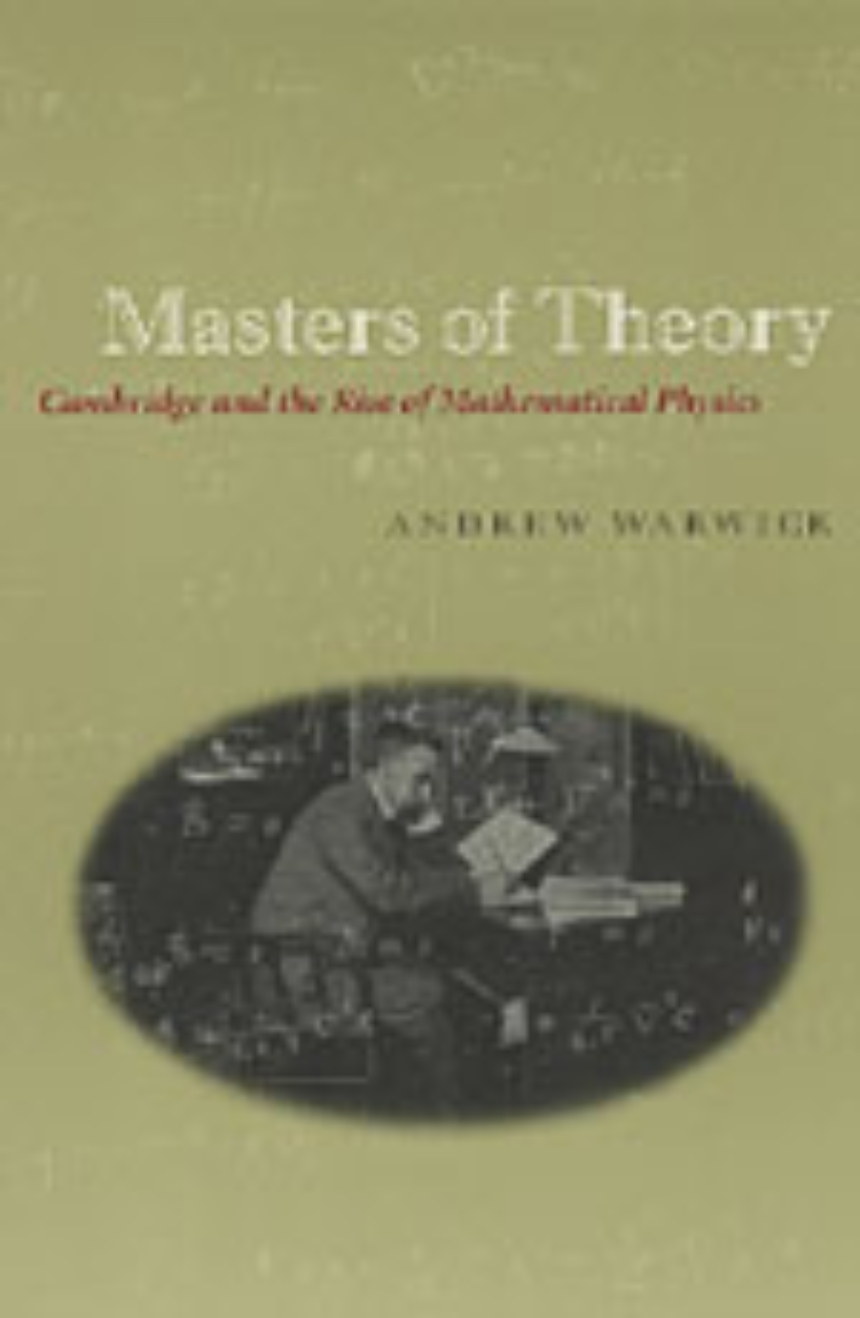Masters of Theory
Cambridge and the Rise of Mathematical Physics
Publication supported by the Susan Elizabeth Abrams Fund in History of Science
Winner of the the Susan Elizabeth Abrams Prize in History of Science.
When Isaac Newton published the Principia three centuries ago, only a few scholars were capable of understanding his conceptually demanding work. Yet this esoteric knowledge quickly became accessible in the nineteenth and early twentieth centuries when Britain produced many leading mathematical physicists. In this book, Andrew Warwick shows how the education of these "masters of theory" led them to transform our understanding of everything from the flight of a boomerang to the structure of the universe.
Warwick focuses on Cambridge University, where many of the best physicists trained. He begins by tracing the dramatic changes in undergraduate education there since the eighteenth century, especially the gradual emergence of the private tutor as the most important teacher of mathematics. Next he explores the material culture of mathematics instruction, showing how the humble pen and paper so crucial to this study transformed everything from classroom teaching to final examinations. Balancing their intense intellectual work with strenuous physical exercise, the students themselves—known as the "Wranglers"—helped foster the competitive spirit that drove them in the classroom and informed the Victorian ideal of a manly student. Finally, by investigating several historical "cases," such as the reception of Albert Einstein’s special and general theories of relativity, Warwick shows how the production, transmission, and reception of new knowledge was profoundly shaped by the skills taught to Cambridge undergraduates.
Drawing on a wealth of new archival evidence and illustrations, Masters of Theory examines the origins of a cultural tradition within which the complex world of theoretical physics was made commonplace.
When Isaac Newton published the Principia three centuries ago, only a few scholars were capable of understanding his conceptually demanding work. Yet this esoteric knowledge quickly became accessible in the nineteenth and early twentieth centuries when Britain produced many leading mathematical physicists. In this book, Andrew Warwick shows how the education of these "masters of theory" led them to transform our understanding of everything from the flight of a boomerang to the structure of the universe.
Warwick focuses on Cambridge University, where many of the best physicists trained. He begins by tracing the dramatic changes in undergraduate education there since the eighteenth century, especially the gradual emergence of the private tutor as the most important teacher of mathematics. Next he explores the material culture of mathematics instruction, showing how the humble pen and paper so crucial to this study transformed everything from classroom teaching to final examinations. Balancing their intense intellectual work with strenuous physical exercise, the students themselves—known as the "Wranglers"—helped foster the competitive spirit that drove them in the classroom and informed the Victorian ideal of a manly student. Finally, by investigating several historical "cases," such as the reception of Albert Einstein’s special and general theories of relativity, Warwick shows how the production, transmission, and reception of new knowledge was profoundly shaped by the skills taught to Cambridge undergraduates.
Drawing on a wealth of new archival evidence and illustrations, Masters of Theory examines the origins of a cultural tradition within which the complex world of theoretical physics was made commonplace.
586 pages | 15 halftones, 39 line drawings | 6 x 9 | © 2003
Physical Sciences: History and Philosophy of Physical Sciences, Physics--Popular Books
Table of Contents
List of Illustrations
Preface and Acknowledgments
Note on Conventions and Sources
1 Writing a Pedagogical History of Mathematical Physics
2 The Reform Coach Teaching Mixed Mathematics in Georgian and
Victorian Cambridge
3 A Mathematical World on Paper The Material Culture and Practice-
Ladenness of Mixed Mathematics
4 Exercising the Student Body Mathematics, Manliness, and
Athleticism
5 Routh’s Men Coaching, Research, and the Reform of Public Teaching
6 Making Sense of Maxwell’s Treatise on Electricity and Magnetism
in Mid-Victorian Cambridge
7 Joseph Larmor, the Electronic Theory of Matter, and the Principle
of Relativity
8 Transforming the Field The Cambridge Reception of Einstein’s Special
Theory of Relativity
9 Through the Convex Looking Glass A.S. Eddington and the Cambridge
Reception of Einstein’s General Theory of Relativity
Epilogue: Training, Continuity, and Change
Appendix A: Coaching Success, 1865-1909
Appendix B: Coaching Lineage, 1865-1909
Bibliography
Index
Preface and Acknowledgments
Note on Conventions and Sources
1 Writing a Pedagogical History of Mathematical Physics
2 The Reform Coach Teaching Mixed Mathematics in Georgian and
Victorian Cambridge
3 A Mathematical World on Paper The Material Culture and Practice-
Ladenness of Mixed Mathematics
4 Exercising the Student Body Mathematics, Manliness, and
Athleticism
5 Routh’s Men Coaching, Research, and the Reform of Public Teaching
6 Making Sense of Maxwell’s Treatise on Electricity and Magnetism
in Mid-Victorian Cambridge
7 Joseph Larmor, the Electronic Theory of Matter, and the Principle
of Relativity
8 Transforming the Field The Cambridge Reception of Einstein’s Special
Theory of Relativity
9 Through the Convex Looking Glass A.S. Eddington and the Cambridge
Reception of Einstein’s General Theory of Relativity
Epilogue: Training, Continuity, and Change
Appendix A: Coaching Success, 1865-1909
Appendix B: Coaching Lineage, 1865-1909
Bibliography
Index
Awards
University of Chicago Press: Susan E. Abrams Prize in History of Science
Won
